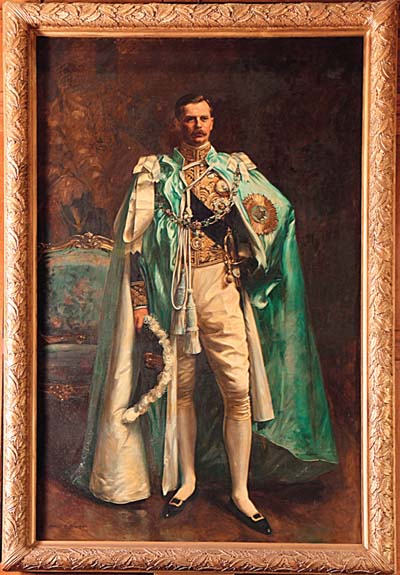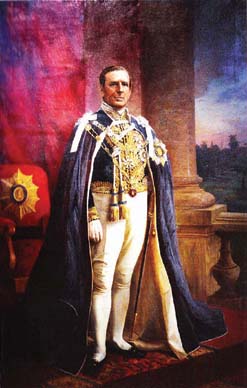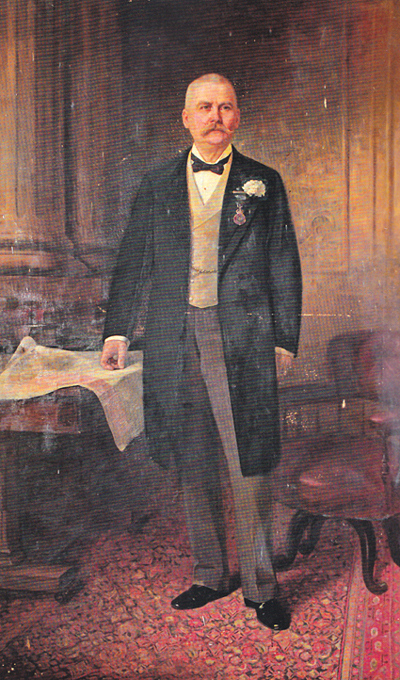|
(Continued from last fortnight)
Though the Varmas used to halt briefly in Madras on their way to various Princely States and towns in the North and also to towns within the Madras Presidency, they did not make the Presidential Capital a base. In 1902, however, the brothers were back in Madras for a long stay. By then, Ravi Varma was an artist known country-wide and he, therefore, had a number of commissions to execute in the city, most of which had to be ready for the Industrial and Arts Exhibition of 1903. The prominent worthies of Madras who sat for Ravi Varma included Sir V. Bhashyam Iyengar, Sir S. Subramania Iyer (both portraits were displayed at the Vakils’ Association, but have since vanished), Lodd Govinddoss, the famed financier whose guests the Varmas were during this visit, a Mrs. Naidu and Sir George Moore, President of the Corporation of Madras (this portrait hangs in Ripon Building). The progress of the painting of the last subject was documented on a day by day basis by Raja Varma, and his diary entries make for interesting reading (see box).
 Lord Ampthill. (Collection: Raj Bhavan, Ooty). |
A subject who was painted in absentia was Sir Arthur Havelock, Governor of Madras between 1896 and 1900. He had already left to take up his subsequent assignment as Governor of Tasmania. But by then the wonder of photography made the Varma brothers’ task easier and in 1903 they received a letter from Havelock who wrote that several of those who had seen the portrait had commented on the “excellence of the likeness to the original.” By then, Raja Varma was evidently considered by his elder brother to be an equal, for Havelock’s portrait as also that of Sir George Moore were signed by both of them. From the jottings from Raja Varma’s diary, it is also possible to infer that, by then, it was the younger brother who was doing a lot of the work, with Ravi Varma giving the finishing touches.
A total of ten works of Ravi Varma (some jointly with Raja Varma) were displayed at the Industrial and Fine Arts Exhibition of 1903. The Hindu, reporting on the inauguration on December 26, noted that Ravi Varma was one among the prominent people seated close to the dais.
 Sir Arthur Havelock (Collection: Fort Museum). |
It was also during this prolonged stay in the city that Ravi Varma found time to consult Major R. Robertson of the Indian Medical Service about the possibility of his being diabetic. The initial diagnosis was negative and he was given a few medicines and assured that the problem would go away. That was not to be. Adding to his sufferings was the sudden death of Raja Varma while they were in Mysore in 1904.
It was while in mourning for his brother that Ravi Varma executed a portrait of Lord Ampthill, Governor of Madras between 1900 and 1906. This hangs in the Freemason’s Hall, Egmore.
By then the painter did not have long to live. By 1905, diabetes had marked him for its own and, in 1906, a carbuncle, the size of a mango, meant that he did not have long to live. The end came on October 3, 1906 at Killimanoor.
The Hindu carried an obituary on the 4th where it rightly declared that his “painting has exerted a unique influence on the minds of our countrymen.” That this is true today also is confirmed by the prices at which even prints of Ravi Varmas are now bought and sold across the country as well as by the calendar art that still proliferates.
By dying when he did, Ravi Varma was spared the trauma of yet another tragedy – the collapse of Arbuthnot Bank which took place towards the end of 1906. The brothers evidently banked with Arbuthnot’s, for the book carries a few extracts from Raja Varma’s diaries to this effect.
 Sir George Moore (Collection: Municipal Corporation of Chennai). |
The record of an artist
The diary entries of Raja Varma while the portrait of Sir George Moore was in progress:
Tuesday, 16th September 1902: This morning at 10.30. Sir George Moore gave us the first sitting at Pator’s Gardens (this must be Patter’s Gardens, the residence of Lodd Govinddoss). This portrait is a whole length life size one.
Thursday, 18th September 1902: Sir George Moore gave us his second sitting.
Friday, 19th September 1902: Sir George Moore sat for the third time. We painted his coat and waistcoat. The sittings never extended to more than an hour and a half.
Sunday, 21st September 1902: Sir George sat for his trousers and boots.
Monday, 22nd September 1902: In the morning, a sitting from Sir George.
Tuesday, 23rd September 1902: At 10.00 am, sitting from Sir George. The face not quite satisfactory yet.
Saturday, 27th September 1902: Worked in the morning on Sir George’s portrait.
Monday, 6th October 1902: Sir George gave another sitting, but we could not finish the face, which is rather difficult for a painter.
Tuesday, 7th October 1902: I worked on Sir George’s carpet, which, though of our choosing, is of an intricate design.
Thursday, 9th October 1902: This morning I finished the carpet.
Wednesday, 22nd October 1902: I have been doing Sir George Moore’s background this morning and a portion of his coat.
Friday, 24th October 1902: Day wet and rainy. In the morning Sir George called and was pleased with his portrait, which is almost entirely my own work.
Saturday, 25th October 1902: Sir George whom we were expecting came rather late and so we postponed the sitting to Monday.
Monday, 27th October 1902: Sir George again late and the weather being very gloomy could do no work.
Thursday, 30th October 1902: Received samples of gilt frames from the Bombay Fine Arts Gallery. We preferred the smaller of the kinds for Rs 175. The frame is for Sir George Moore’s portrait.
|
(Concluded)
|